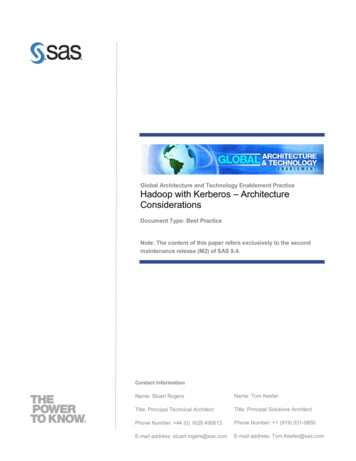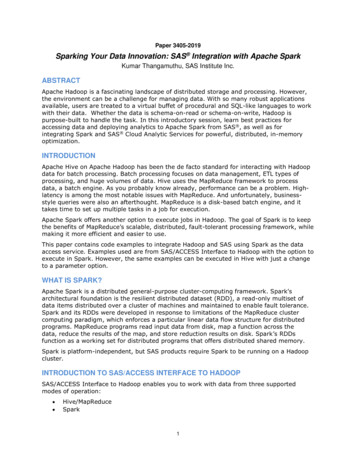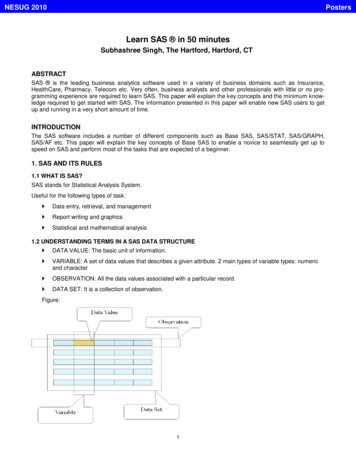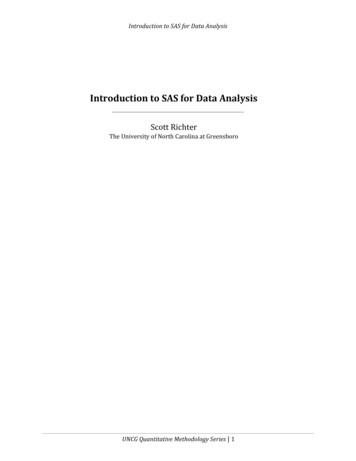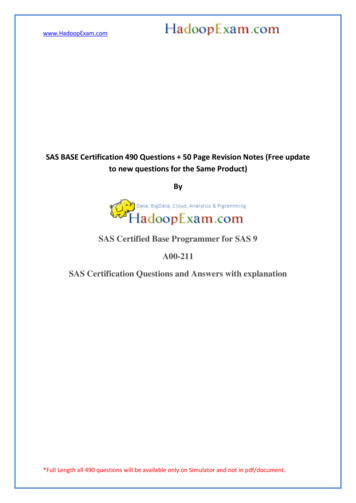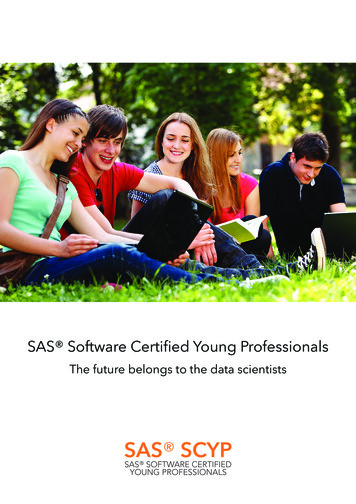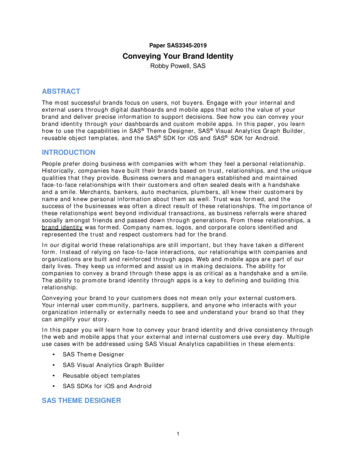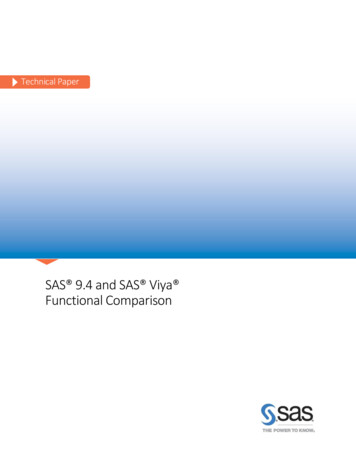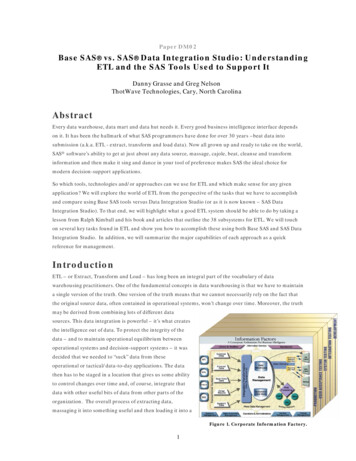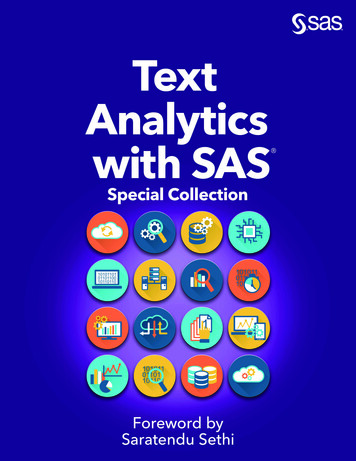
Transcription
The correct bibliographic citation for this manual is as follows: Sethi, Saratendu. 2019. Text Analytics with SAS : Special Collection.Cary, NC: SAS Institute Inc.Text Analytics with SAS : Special CollectionCopyright 2019, SAS Institute Inc., Cary, NC, USAISBN 978-1-64295-184-4 (PDF)All Rights Reserved. Produced in the United States of America.For a hard-copy book: No part of this publication may be reproduced, stored in a retrieval system, or transmitted, in any form or by any means,electronic, mechanical, photocopying, or otherwise, without the prior written permission of the publisher, SAS Institute Inc.For a web download or e-book: Your use of this publication shall be governed by the terms established by the vendor at the time you acquirethis publication.The scanning, uploading, and distribution of this book via the Internet or any other means without the permission of the publisher is illegal andpunishable by law. Please purchase only authorized electronic editions and do not participate in or encourage electronic piracy of copyrightedmaterials. Your support of others’ rights is appreciated.U.S. Government License Rights; Restricted Rights: The Software and its documentation is commercial computer software developed atprivate expense and is provided with RESTRICTED RIGHTS to the United States Government. Use, duplication, or disclosure of the Softwareby the United States Government is subjectto the license terms of this Agreement pursuant to, as applicable, FAR 12.212, DFAR 227.7202-1(a), DFAR 227.7202-3(a), and DFAR227.7202-4, and, to the extent required under U.S. federal law, the minimum restricted rights as set out in FAR 52.227-19 (DEC 2007). If FAR52.227-19 is applicable, this provision serves as notice under clause (c) thereof and no other notice is required to be affixed to the Software ordocumentation. The Government’s rights in Software and documentation shall be only those set forth in this Agreement.SAS Institute Inc., SAS Campus Drive, Cary, NC 27513-2414March 2019SAS and all other SAS Institute Inc. product or service names are registered trademarks or trademarks of SAS Institute Inc. in the USA andother countries. indicates USA registration.Other brand and product names are trademarks of their respective companies.SAS software may be provided with certain third-party software, including but not limited to open-source software, which is licensed under itsapplicable third-party software license agreement. For license information about third-party software distributed with SAS software, refer tohttp://support.sas.com/thirdpartylicenses.
Table of ContentsAnalyzing Text In-Stream and at the Edgeby Simran Bagga and Saratendu SethiHarvesting Unstructured Data to Reduce Anti-Money Laundering (AML) Compliance Riskby Austin Cook and Beth HerronInvoiced: Using SAS Text Analytics to Calculate Final Weighted Average Priceby Alexandre CarvalhoUsing SAS Text Analytics to Assess International Human Trafficking Patternsby Tom Sabo and Adam PilzAn Efficient Way to Deploy and Run Text Analytics Models in Hadoopby Seung Lee, Xu Yang, and Saratendu SethiApplying Text Analytics and Machine Learning to Assess Consumer Financial Complaintsby Tom SaboExploring the Art and Science of SAS Text Analytics: Best Practices in Developing Rule-Based Modelsby Murali Pagolu, Christina Engelhardt, and Cheyanne Baird
Free SAS e-Books:Special CollectionIn this series, we have carefully curated a collection of papers that introducesand provides context to the various areas of analytics. Topics coveredillustrate the power of SAS solutions that are available as tools fordata analysis, highlighting a variety of commonly used techniques.Discover more free SAS for additional books and resources.SAS and all other SAS Institute Inc. product or service names are registered trademarks or trademarks of SAS Institute Inc. in the USA and other countries. indicates USA registration.Other brand and product names are trademarks of their respective companies. 2017 SAS Institute Inc. All rights reserved. M1673525 US.0817
About This BookWhat Does This Collection Cover?Frequently, organizations assume that data analytics begins and ends with structured data such as a spreadsheetor database. What happens, though, if an organization wants to analyze unstructured data, such as call centernotes, customer reviews or social media posts? Enter text analytics. Text analytics allows organizations toclassify raw text into meaningful categories, extract needed facts from documents, and measure sentiment. Textanalytics are based on statistical, linguistic and machine learning rules, and turn unstructured data intoactionable insights.SAS offers many different solutions to analyze text. The papers included in this special collection demonstratethe wide-ranging capabilities and applications of text analytics across several industries.The following papers are excerpts from the SAS Global Users Group Proceedings. For more SAS GlobalForum Proceedings, visit the online versions of the Proceedings.More helpful resources are available at support.sas.com and sas.com/books.We Want to Hear from YouDo you have questions about a SAS Press book that you are reading? Contact us at saspress@sas.com.SAS Press books are written by SAS Users for SAS Users. Please visit sas.com/books to sign up to requestinformation on how to become a SAS Press author.We welcome your participation in the development of new books and your feedback on SAS Press books thatyou are using. Please visit sas.com/books to sign up to review a bookLearn about new books and exclusive discounts. Sign up for our new books mailing list today .html.
vi
ForewordText analytics, also known as text analysis or text mining, is the automated process of deriving importantinformation from unstructured text data. The study of text analytics started around the 1950s when researchersattempted to analyze human language through computational and linguistic methods. Since then, text analyticshas grown into an interdisciplinary field by expanding the analysis of unstructured data to apply approachesfrom information theory, statistics, machine learning, and artificial intelligence. These developments, alongwith the exponential increase in the computational power of computers and the emergence of big data, have ledorganizations to foster data-positive cultures that rely on highly sophisticated applications to make businessdecisions based on analysis of internal documents, internet, social media, and speech data. Today, text analyticshelps solve a variety of everyday business problems – such as managing and interpreting notes, assessing risk orfraud, and incorporating customer feedback for earlier problem resolution.SAS Text Analytics is designed for business analysts, domain experts, research analysts, linguists, knowledgeworkers, and data scientists who need to analyze large amounts of unstructured data to glean new insights. Itoffers powerful tools for consolidating, categorizing, and retrieving information across an enterprise throughsupervised and unsupervised machine learning, deep learning, linguistic rules, entity extraction, sentimentanalysis, and topic detection.SAS provides many different solutions to investigate and analyze text and operationalize decisioning. Severalimpressive papers have been written to demonstrate how to use these techniques. We have carefully selected ahandful of these from recent Global Forum contributions to introduce you to the topic and let you sample whateach has to offer:Analyzing Text In-Stream and at the Edge by Simran Bagga and Saratendu SethiAs companies increasingly use automation for operational intelligence, they are deploying machines toread, and interpret in real time, unstructured data such as news, emails, network logs, and so on. Realtime streaming analytics maximizes data value and enables organizations to act more quickly. Companiesare also applying streaming analytics to provide optimal customer service at the point of interaction,improve operational efficiencies, and analyze themes of chatter about their offerings. This paper explainshow you can augment real-time text analytics (such as sentiment analysis, entity extraction, contentcategorization, and topic detection) with in-stream analytics to derive real-time answers for innovativeapplications such as quant solutions at capital markets, fake-news detection at online portals, and others.Harvesting Unstructured Data to Reduce Anti-Money Laundering (AML) Compliance Risk by AustinCook and Beth HerronAs an anti-money laundering (AML) analyst, you face a never-ending job of staying one step ahead ofnefarious actors (for example, terrorist organizations, drug cartels, and other money launderers). One areagaining traction in the financial services industry is to leverage the vast amounts of unstructured data togain deeper insights. This paper explores the potential use cases for text analytics in AML and providesexamples of entity and fact extraction and document categorization of unstructured data using SAS Visual Text Analytics.Invoiced: Using SAS Text Analytics to Calculate Final Weighted Average Price by Alexandre CarvalhoSAS Contextual Analysis brings advantages to the analysis of the millions of electronic tax notes issuedin the industry and improves the validation of taxes applied. Tax calculation is one of the analyticalchallenges for government finance secretaries. This paper highlights two items of interest in the publicsector: tax collection efficiency and the calculation of the final weighted average consumer price. SASContextual Analysis enables the implementation of a tax taxonomy that analyzes the contents of invoices,automatically categorizes a product, and calculates a reference value of the prices charged in the market.
viii ForewordUsing SAS Text Analytics to Assess International Human Trafficking Patterns by Tom Sabo and Adam PilzThe US Department of State (DOS) and other humanitarian agencies have a vested interest in assessingand preventing human trafficking in its many forms. A subdivision within the DOS releases publiclyfacing Trafficking in Persons (TIP) reports for more than 200 countries annually. These reports areentirely freeform text, though there is a richness of structure hidden within the text. How can decisionmakers quickly tap this information for patterns in international human trafficking? This paper showcasesa strategy of applying SAS Text Analytics to explore the TIP reports and apply new layers of structuredinformation. Specifically, we identify common themes across the reports, use topic analysis to identify astructural similarity across reports, identifying source and destination countries involved in trafficking,and use a rule-building approach to extract these relationships from freeform text.An Efficient Way to Deploy and Run Text Analytics Models in Hadoop by Seung Lee, Xu Yang, andSaratendu SethiSignificant growth of the Internet has created an enormous volume of unstructured text data. In recentyears, the amount of this type of data that is available for analysis has exploded. While the amount oftextual data is increasing rapidly, an ability to obtain key pieces of information from such data in a fast,flexible, and efficient way is still posing challenges. This paper introduces SAS Contextual Analysis InDatabase Scoring for Hadoop, which integrates SAS Contextual Analysis with the SAS EmbeddedProcess. SAS Contextual Analysis enables users to customize their text analytics models in order torealize the value of their text-based data. The SAS Embedded Process enables users to take advantage ofSAS Scoring Accelerator for Hadoop to run scoring models. By using these key SAS technologies, theoverall experience of analyzing unstructured text data can be greatly improved. The paper also providesguidelines and examples on how to publish and run category, concept, and sentiment models for textanalytics in Hadoop.Applying Text Analytics and Machine Learning to Assess Consumer Financial Complaints by Tom SaboThe Consumer Financial Protection Bureau (CFPB) collects tens of thousands of complaints againstcompanies each year, many of which result in the companies in question taking action, including makingpayouts to the individuals who filed the complaints. Given the volume of the complaints, how can anoverseeing organization quantitatively assess the data for various trends, including the areas of greatestconcern for consumers? In this presentation, we propose a repeatable model of text analytics techniquesto the publicly available CFPB data. Specifically, we use SAS Contextual Analysis to explore sentimentand machine learning techniques to model the natural language available in each freeform complaintagainst a disposition code for the complaint, primarily focusing on whether a company paid out money.This process generates a taxonomy in an automated manner. We also explore methods to structure andvisualize the results, showcasing how areas of concern are made available to analysts using SAS VisualAnalytics and SAS Visual Statistics. Finally, we discuss the applications of this methodology foroverseeing government agencies and financial institutions alike.Exploring the Art and Science of SAS Text Analytics: Best Practices in Developing Rule-Based Modelsby Murali Pagolu, Christina Engelhardt, and Cheyanne BairdTraditional analytical modeling, with roots in statistical techniques, works best on structured data.Structured data enables you to impose certain standards and formats in which to store the data values.The nuances of language, context, and subjectivity of text make it more complex to fit generalizedmodels. Although statistical methods using supervised learning prove efficient and effective in somecases, sometimes you need a different approach. These situations are when rule-based models withNatural Language Processing capabilities can add significant value. In what context would you choose arule-based modeling versus a statistical approach? How do you assess the tradeoffs of choosing a rulebased modeling approach with higher interpretability versus a statistical model that is black-box innature? How can we develop rule-based models that optimize model performance without compromisingaccuracy? How can we design, construct, and maintain a complex rule-based model? What is a datadriven approach to rule writing? What are the common pitfalls to avoid? In this paper, we discuss allthese questions based on our experiences working with SAS Contextual Analysis and SAS SentimentAnalysis.
Foreword ixWe hope these selections give you a useful overview of the many tools and techniques that are available toanalyze text.Additionally, SAS offers free video tutorials on text analytics. For more information, go tohttps://video.sas.com/category/videos/ and enter “text analytics” in the search box.Saratendu SethiSr Director, Advanced Analytics R&DSaratendu Sethi is Head of Artificial Intelligence and Machine Learning R&D atSAS Institute. He leads SAS’ software development and research teams forArtificial Intelligence, Machine Learning, Cognitive Computing, Deep Learning,and Text Analytics. Saratendu has extensive experience in building global R&Dteams, launching new products and business strategies. Perennially fascinated byhow technology enables a creative life, he is a staunch believer in transformingpowerful algorithms into innovative technologies. At SAS, his teams developmachine learning, cognitive- and semantic-enriched capabilities for unstructureddata and multimedia analytics. He joined SAS Institute through the acquisition ofTeragram Corporation, where he was responsible for the development of naturallanguage processing and text analytics technologies. Before joining Teragram,Saratendu held research positions at the IBM Almaden Research Center and at Boston University, specializingin computer vision, pattern recognition, and content-based search.
x Foreword
Paper SAS1962-2018Analyzing Text In-Stream and at the EdgeSimran Bagga and Saratendu Sethi, SAS Institute Inc.ABSTRACTAs companies increasingly use automation for operational intelligence, they are deploying machines toread, and interpret in real time, unstructured data such as news, emails, network logs, and so on. Realtime streaming analytics maximizes data value and enables organizations to act more quickly. Forexample, being able to analyze unstructured text in-stream and at the “edge” provides a competitiveadvantage to financial technology (fintech) companies, who use these analyses to drive algorithmictrading strategies. Companies are also applying streaming analytics to provide optimal customer serviceat the point of interaction, improve operational efficiencies, and analyze themes of chatter about theirofferings. This paper explains how you can augment real-time text analytics (such as sentiment analysis,entity extraction, content categorization, and topic detection) with in-stream analytics to derive real-timeanswers for innovative applications such as quant solutions at capital markets, fake-news detection atonline portals, and others.INTRODUCTIONText analytics is appropriate when the volume of unstructured text content can no longer be economicallyreviewed and analyzed manually. The output of text analytics can be applied to a variety of business usecases: detecting and tracking service or quality issues, quantifying customer feedback, assessing risk,improving operational processes, enhancing predictive models, and many more. SAS Visual TextAnalytics provides a unified and flexible framework that enables you to tackle numerous use cases bybuilding a variety of text analytics models. A pipeline-based approach enables you to easily connectrelevant nodes that you can use to generate these models.Concepts models enable you to extract entities, concepts, and facts that are relevant to the business.Topic models exploit the power of natural language processing (NLP) and machine learning to discoverrelevant themes from text. You can use Categories and Sentiment models to tag emotions and revealinsights and issues.Growing numbers of devices and dependency on Internet of Things (IoT) are causing an increasing needfor faster processing, cloud adoption, edge computing, and embedded analytics. The ability to analyzeand score unstructured text in real time as events are streaming in is becoming more critical than ever.This paper outlines the use of SAS Visual Text Analytics and SAS Event Stream Processing todemonstrate a complex event processing scenario. Text models for concept extraction, documentcategorization, and sentiment analysis are deployed in SAS Event Stream Processing to gain real-timeinsights and support decision making that is based on intelligence gathered from streaming events.Big data typically come in dribs and drabs from various sources such as Facebook, Twitter, banktransactions, sensor reading, logs, and so on. The first section of this paper uses SAS Visual TextAnalytics to analyze data from trending financial tweets. The latter half focuses on the deployment of textmodels within SAS Event Stream Processing to assess market impact and intelligently respond to each ofthe events or data streams as they come in.1
EXTRACTING INTELLIGENCE FROM UNSTRUCTURED TEXT USING SAS VISUALTEXT ANALYTICSSAS Visual Text Analytics provides a modern, flexible, and end-to-end analytics framework for building avariety of text analytics models that address many use cases. You can exploit the power of naturallanguage processing (NLP), machine learning, and linguistic rules within this single environment. Themain focus of NLP is to extract key elements of interest, which can be terms, entities, facts, and so on.Display 1 demonstrates a custom pipeline that you might assemble for a text analytics processing flow.The Concepts node and the Text Parsing node give you the flexibility to enhance the output of NLP andcustomize the extraction process.Display 1. Custom Pipeline in SAS Visual Text AnalyticsThe following list describes the role of each node in this custom pipeline. In the Concepts node, you include predefined concepts such as nlpDate, nlpMoney,nlpOrganization, and so on. In this node, you can also create custom concepts and extend thedefinitions for predefined concepts that are already built into the software. Display 2 shows somecustom concepts that have been built to extract information that is related to customer service,corporate reputation, executive appointment, partnerships, and so on, and is likely to affectmarket trading and volatility. These custom concepts are used for associating categories to eachevent in SAS Event Stream Processing and will enable automatic concept extraction in futurenarratives.2
Display 2. Concepts Extraction in SAS Visual Text AnalyticsIn addition, a custom concepts model is also developed to identify stock ticker symbols in eachevent. This custom concept model is shown in Display 3.Display 3. Extracting Stock Ticker Symbols from Text in SAS Visual Text Analytics3
The Text Parsing node automatically extracts terms and noun groups from text by associatingdifferent parts of speech and understanding the context. Recommended lists of Keep and Dropterms are displayed in the interactive window. After the node execution is complete, you canright-click on the node to open the interactive window and drop terms that are not relevant fordownstream analysis. The Term Map within the interactive window helps you understand theassociation of other terms to the term “trading.” See Display 4.Display 4. Term Map in SAS Visual Text Analytics The Sentiment node uses a domain-independent model that is included with SAS Visual TextAnalytics. This rules-based analytic model computes sentiment relevancy for each post andclassifies the emotion in unstructured text as positive, negative, or neutral. You can deploy thesentiment model in SAS Event Stream Processing to tag emotions that are associated with a postand that might affect trading decisions. The final list of terms from text parsing are fed into machine learning for topic detection. In theinteractive window of the Text Topics node (see Display 5), you can see commonly occurringthemes within a set of tweets. For example, if you select your topic of interest as “ day, optionsday, 7 day, team, offering,” the Documents pane shows all the tweets that mention that topicand the terms that exist within that topic, in addition to relevancy and sentiment. You can deploythe Topics model in-stream in order to capture themes as data or events are streaming in. Youcan also promote topics of interest into your Categories model, which you can deploy in order toclassify text into multiple categories. The implementation of this example uses some categoriesthat were created by promoting relevant topics.4
Display 5. Text Topics in SAS Visual Text Analytics In the Categories node, you see the taxonomy (Display 6) that has been designed for documentcategorization. You can manually extend the auto-generated rules from promoted topics and referto the previously created concepts within your category rules. You can also use the TextualElements table to select elements of interest that can be inserted into new rules. Multiple posts ortweets about bankruptcy or layoffs, or about an increase or decrease in the number of shares,often result in stock trading shortly thereafter. This intelligence, if available in real time, can aid inbuy or sell decisions that are related to that company.Display 6. Categorization in SAS Visual Text Analytics5
SCORING FINANCIAL POSTS IN REAL TIME TO ASSESS MARKET IMPACTSAS Event Stream Processing is a streaming engine that enables you to analyze or score data as theystream in, rather than first storing them in the database and then analyzing and scoring them in batch.Being able to react to the clicks and events as they are coming in reduces time to action. Event streamprocessing can occur in three distinct places: at the edge of the network, in the stream, or on data that’sat rest (out of the stream).The SAS Event Stream Processing engine is a transformation engine that augments and adds value toincoming event streams. It is capable of processing millions of events per second. You can performtraditional data management tasks such as filtering out unimportant events, aggregating data, improvingdata quality, and applying other computations. You can also perform advanced analytic tasks such aspattern detection and text analysis. Events coming in from any source—sensors, Wall Street feeds, routerfeeds, message buses, server log files—can be read, analyzed, and written back to target applications inreal time.COMPARING STOCK TRADING WEIGHTED AVERAGE PRICE OVER THREE RETENTIONPERIODSThe SAS Event Stream Processing studio is a development and testing application for event streamprocessing (ESP) models. An ESP model is a program or set of instructions that transforms the inputevent streams into meaningful output event streams. Once the models are built, they can be publishedinto SAS Event Stream Processing for scoring.In the ESP model presented in Display 7, the Source window (named TradesSource) is reading from onemillion stock trades, which are all structured data. The three Copy windows define three different levels ofevent retention: 5 minutes, 1 hour, and 24 hours. The three Aggregate windows create weighted averagetrade amounts by stock symbol.Display 7. Model Viewer in SAS Event Stream ProcessingThe Stream Viewer window in SAS Event Stream Processing provides a dashboard that enables you tovisualize streaming events. This example creates three subscriptions for the three aggregate windows,which can viewed in the dashboard of the Stream Viewer. The dashboard in Display 8 compares thestock trading weighted average price over three retention periods: 5 minute, 1 hour, and 24 hours. The 5minute view shows what the market is doing right now, whereas the 24-hour view shows what the full dayof the market looks like.6
Display 8. Dashboard Viewer in SAS Event Stream ProcessingSTOCK RECOMMENDATION BASED ON ANALYSIS OF UNSTRUCTURED TEXTThe models that are built using SAS Visual Text Analytics can applied in batch, in-Hadoop, in-stream, andat the edge. This section uses SAS Event Stream Processing to extract concepts, analyze sentimentabout particular companies and their stock, and categorize posts as events stream in real time.In the process defined in Display 9, tweets are continuously flowing through. The Source window (namedFinancialTweets) has a retention policy of 15 minutes, which means that the analysis recommendation isbased on the last 15 minutes of captured events. As the tweets come in, they are analyzed: stocks tickersare extracted, sentiment score is assigned, and the content is tagged for appropriate categories.Display 9. SAS Event Stream Processing Studio7
The following list describes each window in Display 9 and its role in the flow. FinancialTweets: This is a Source window, which is required for each continuous query. All eventstreams enter continuous queries by being published (injected) into a Source window. Eventstreams cannot be published into any other window type. Source windows are typically connectedto one or more derived windows. Derived windows can detect patterns in the data, transform thedata, aggregate the data, analyze the data, or perform computations based on the data. Thisexample uses a CSV (comma-separated values) file with a small sample of tweets that arerelated to financial and corporate information. Because the sample is small, the results derivedhere are purely a proof of concept rather than a true financial analysis for all publicly tradedcompanies. For a true streaming use case, SAS Event Stream Processing provides a Twitteradapter, which can be used to feed tweets in real time. SelectColumns: This Compute window enables a one-to-one transformation of input events tooutput events through computational manipulation of the input event stream fields. You can usethe Compute window to project input fields from one event to a new event and to augment thenew event with fields that result from a calculation. You can change the set of key fields within theCompute window. This example uses the SelectColumns window to filter out attributes that arenot relevant for downstream analysis. Categories: This is a Text Category window, which categorizes a text field in incoming events.The text field can generate zero or more categories, with scores. Text Category windows areinsert-only. This example uses the model file (.mco) that is generated by the Download ScoreCode option of the Categories node in SAS Visual Text Analytics. Display 10 shows the outputthat is generated by this window. The output lists the document ID ( Index column), categorynumber (catNum column), tagged category (category column), and the relevancy score forassigned categorization (score column).Display 10. Text Category Window Output8
Sentiment: This is a Text Sentiment window, which determines the sentiment of text in thespecified incoming text field and the probability of its occurrence. The sentiment value is positive,neutral, or negative. The probability is a value between 0 and 1. Text Sentiment windows areinsert-only. This example uses the domain-independent sentiment model file (en-base.sam),which is included in SAS Visual Text Analytics. Display 11 shows the output that is generated bythis window. Upon scoring, each document in the Index column is assigned an appropriatesentiment tag (in the sentiment column) along with a relevancy score (in the probability column).Display 11. Text Sentiment Window Output CategorySentiment: This is a Join window, which receives events from an
Text analytics, also known as text analysis or text mining, is the automated process of deriving important information from unstructured text data. The study of text analytics started around the 1950s when researchers attempted to analyze human language through computational and lingui

